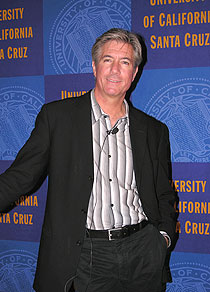When memorials celebrate a nation's triumphs, they take a grand approach: classic columns, towering arches, soaring stairways. But how might people memorialize "a crime perpetrated in their name"? When the Berlin Senate commissioned a panel to select the design for Germany's national "Memorial to Europe's Murdered Jews," they had to grapple with this question. Alumnus James E. Young, an international expert on the construction of memorials, was among them.
Young was at UCSC on Friday, April 27, to describe and illustrate his experience in a multimedia presentation entitled "Berlin's Holocaust Memorial Problem--And Mine." The public talk was part of a literature and history course on the Holocaust, taught by history professor Peter Kenez and Murray Baumgarten, professor of English and Comparative Literature and director of UCSC's Jewish studies program. Some 250 students, staff, and faculty attended.
Young took his audience on a fascinating tour of contemporary memorials around the globe. The Vietnam Veterans Memorial in Washington, D.C., designed by architect Maya Lin, has strongly influenced other architects with its minimalist design: a granite wall inscribed with the names of dead and missing American soldiers, so shiny that viewers see their own image superimposed on the list of names. Designs such as this can "show you yourself, and help you reflect on your own need for memory," Young said.
Some memorials do this in innovative ways, according to Young. One commemorated Nazi book-burnings with an empty underground "book room;" as they look through glass tiles in the ground, viewers literally bow their heads in contemplation. Elsewhere in Europe, elevated cobblestones, each with the name of a murdered Jewish family, literally trip up pedestrians. At the Berlin memorial, viewers get lost in a sea of rectangle forms. These memorials can help us realize that "what we need to remember is not the destruction, but the void left behind," he said.
With Young's help, New York's 9/11 memorial may achieve this as well. In 2003, he was appointed by the Lower Manhattan Development Corporation to the jury for the World Trade Center Site Memorial competition. That memorial is now under construction.
During his visit to UCSC, Young said he felt indebted to UCSC-"where I became a humanist." After earning his bachelor's degree in psychology and literature in 1973, the Stevenson graduate went on to get his Ph.D. in literature from UCSC in 1983.
Young is professor of English and Judaic Studies at the University of Massachusetts, and chair of the Department of Judaic and Near Eastern Studies. He is the author of several books, including The Texture of Memory (Yale University Press, 1993), which won the National Jewish Book Award in 1994.



